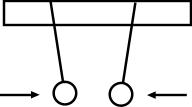
Bernoulli’s Principle Demonstration
Simple Science Trick with Ping Pong Balls
Bernoulli’s Principle explains how air moves. It says that fast-moving air has lower pressure than slow-moving air. This idea helps us understand many things, like how planes fly.
Daniel Bernoulli was a scientist who studied fluids. He found that when air moves faster, it pushes less. This means that areas with fast air have lower pressure.
Think about blowing over a piece of paper. The paper lifts up. That’s because the fast air above has lower pressure, and the higher pressure below pushes the paper up.
This principle is used in many places. Airplanes use it to lift off the ground. Chimneys use it to pull smoke up. Even shower curtains move because of it.
Setting Up the Experiment
You can see Bernoulli’s Principle with a simple experiment. You need two ping pong balls, string, tape, scissors, a table, and a straw.

First, cut two pieces of string, each about six inches long. Tape one end of a string to a ping pong ball. Do the same with the other ball and string.
Next, tape the other ends of the strings to the table. The balls should hang down and be about half an inch apart.
Now, you’re ready to test what happens when you blow air between the balls.
Doing the Experiment
Before starting, ask: What will happen if you blow between the balls? Will they move apart, come together, or stay still?

Use the straw to blow air between the balls. Blow steadily and watch what happens.
You’ll see the balls move toward each other. They might even touch or bounce off each other.
This shows Bernoulli’s Principle in action. The fast air between the balls has lower pressure. The higher pressure on the outside pushes the balls together.
Understanding What Happened
When you blew air between the balls, you created fast-moving air. This air had lower pressure than the still air around it.
Because of the lower pressure between the balls, the higher pressure on the outside pushed them together.
This is the same idea that helps airplanes fly. Air moves faster over the top of the wing, creating lower pressure. The higher pressure below pushes the plane up.
This principle also explains why a shower curtain moves in when you take a hot shower. The moving air lowers the pressure inside, and the higher pressure outside pushes the curtain in.
How This Connects to Scouting
This experiment fits well with many Scouting activities across all age levels. It is simple enough for younger Cub Scouts and still interesting for older Scouts. It gives Scouts a chance to see science with their own eyes. They don’t just hear about it—they do it.
This experiment fits well with many Scouting activities across all age levels. It is simple enough for younger Cub Scouts and still interesting for older Scouts. It gives Scouts a chance to see science with their own eyes. They don’t just hear about it—they do it. Cub Scouts can enjoy this activity as part of their science and engineering learning.
For Wolf Cub Scouts, this can be part of the Air of the Wolf adventure. In that adventure, Wolves learn about air and how it moves. They do activities with air and talk about weather. Blowing between ping pong balls fits right in.
For Scouts BSA, this experiment connects to the Aviation merit badge. Scouts learn how airplanes fly and what helps them lift off the ground. Bernoulli’s Principle is a key part of that. It also fits with the Weather merit badge. That badge covers how air moves and how weather systems form. Scouts can better understand high and low pressure by seeing this in action.
Venturers can use this as part of their STEM exploration. If they are doing anything related to flight or engineering, this is a great fit.
Leaders can use this as a teaching tool. It doesn’t take long to set up. It’s fun and hands-on. And it helps Scouts connect big ideas to real-life examples. It’s a great way to support learning and make science fun at your next meeting or event.
More Resources

The Scout Law
This experiment connects to parts of the Scout Law. Scouts are curious and want to learn. That shows they are trustworthy and helpful. They ask questions, try things out, and help each other understand.
It also shows that Scouts are cheerful and obedient. They follow the steps, take turns, and enjoy learning together. They stay safe, listen to directions, and work as a team. This small science activity helps build good habits and strong character.
Frequently Asked Questions
What is Bernoulli’s Principle?
Bernoulli’s Principle says that fast-moving air has lower pressure than slow-moving air. This lower pressure can cause things to move.
Why do the ping pong balls move together?
When you blow air between the balls, the air moves fast. That fast air has lower pressure. The higher pressure on the outside pushes the balls together.
What if the balls move apart instead?
Make sure you are blowing straight between the balls. If the air hits one ball more than the other, they may move apart. Try again and blow gently and evenly.
Can I use something else instead of ping pong balls?
Ping pong balls work best. They are light and hang easily. Other light balls might work, but they should be smooth and round.
Why do I need a straw?
The straw helps aim the air between the balls. It makes it easier to blow straight and control the air flow.
How does this relate to flight?
Airplane wings are shaped so that air moves faster over the top. This creates lower pressure on top. The higher pressure under the wing lifts the plane.
Is this experiment safe?
Yes, it is safe. Just be careful with scissors and don’t blow too hard. Make sure everyone gets a turn and watches closely.
Can younger Cub Scouts do this?
Yes. This activity is simple. It’s good for Wolves and Bears. Just help them with the setup.
What can I do if the experiment doesn’t work?
Check that the balls are close but not touching. Make sure the strings are the same length. Blow straight between the balls using a steady breath. Try again if needed.
A Little Air, A Lot of Learning
This simple experiment teaches a big idea. By blowing air between two ping pong balls, you can see Bernoulli’s Principle in action. Fast air has lower pressure. This causes the balls to move together. It’s a fun way to learn about air pressure and movement.
You don’t need fancy equipment. Just a few household items. This makes it easy to use at a Cub Scout meeting or a Scouts BSA troop night. It fits well with science themes, flight activities, or STEM fun.
Scouts enjoy seeing the balls move. They like trying it out and making guesses. It helps them learn to ask questions, test ideas, and think like scientists.
Keep this activity in mind when planning hands-on learning. It’s quick, fun, and gives real results. Plus, it helps Scouts connect science to things they see every day—like airplanes and showers. It shows that learning can be simple and exciting.


Leave a Reply